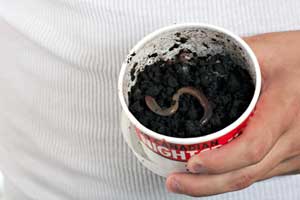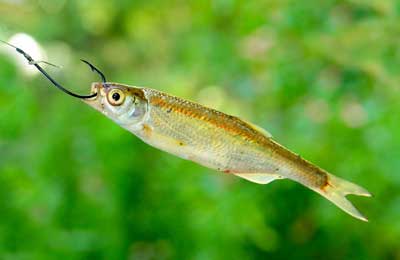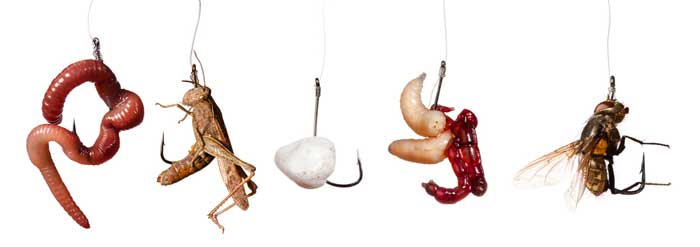Fishing with Other Live Baits

 Hooking Live Bait
Hooking Live Bait
Frogs, minnows and shad will live longer if hooked properly through their front lips or bottom lips and through the nostril.
This technique makes the minnow swim in a downward fashion and is ideal for trolling.
Note: Care needs to be taken to not break the neck of the minnow.
Hooking through the dorsal fin will typically make your bait swim up towards the surface and away from your line and bobber. This will create more action, but your minnow won’t last as long and die sooner.
Hooking through the anal fin close to back bone, without damaging the spine, will make your minnow swim downwards.
Minnows, especially if you’re in weedy areas, can actually be steered under vegetation to exactly where you want them.
Live Bait Presentation
Getting your live bait to the fish in perfect condition can be a challenge. Always remember this when casting.
- Underhand casting or side arm casting prevents rough impact with the water. This will help to keep all the scales intact on your minnow or shiner, and your frog more active.
- If scales are knocked off, they tend to leave white spots on your bait fish and that can be seen underwater. This also makes your bait much weaker.
- Take care and cast with caution. Take your time to land the bait exactly where you want it the first time around. Repeated casts mean an earlier expiring bait.
Always remember you’re fishing with live bait and even more patience is required. Let your frog, minnow, etc., do their job.
 Setting the Hook
Setting the Hook
Typically, most anglers will set their hooks extremely hard.
- How you set the hook is much more important than how hard you set it.
It’s said that women anglers make this point on a regular basis. Strength and power is great, however, skill is even better.
Nylon will stretch.
- Retrieve slack smoothly until you’ve tensed the line and have it tight. This means you have contact with the fish
- You can keep your rod tip down and make an over head hook set
- This way, you’ll surprise your catch maintaining the pressure with bent rod all the way until you have the hook firmly set
Fishing with Live Bait
Fishing with Worms
There’s hundreds of varieties of earthworms and they are, without doubt, the most popular fishing baits.
Want to land more bass? Learn how to catch bass with worms.
Fishing with Minnows
Minnows are a great way to catch bass and many other species of fish and are a very popular option for many anglers. If you’ve never used live bait before, minnows are a great start.
Frog Fishing
Why do so many different types of artificial lures and plastics try to mimic frogs in color and action? Because fish love frogs and they work! Find out how to make frogs work for you.
Fishing with Leeches
Although not as popular as worms and more difficult to catch, leeches are a sure thing when it comes to landing bass. Learn how you can use leeches to put more bass on the end of your line.
Fishing with Crayfish
Fishing with a live crayfish at the end of your line is very common in some regions and less common in others. Find out when and where you should be using crayfish to help you land more bass.
Fishing with Insects
Most stream anglers swear by natural baits in the spring, especially flies. Find out when you should be using natural baits such aquatic insects and how to fish them.
How to Catch Fish with Live Bait
One of the easiest ways to start catching fish is with live bait. If you’re wanting to teach children to fish, there’s no easier way to create a positive experience for them than to start with live bait. Start them with worms or leeches and when they grow in confidence and skill, switch them to lures.
Properly presented, natural baits such as worms, leeches and minnows will consistently outfish artificial lures no matter how well the artificials are presented.
Once used to live baits, and the success of live baits, it may seem laughable that bass will bite on some big plug fitted with treble hooks with loud colors.


